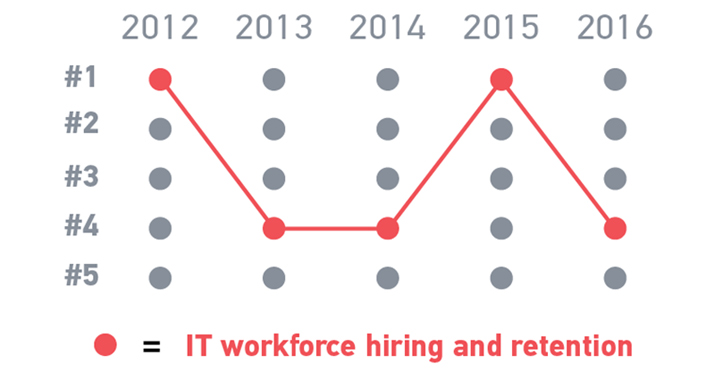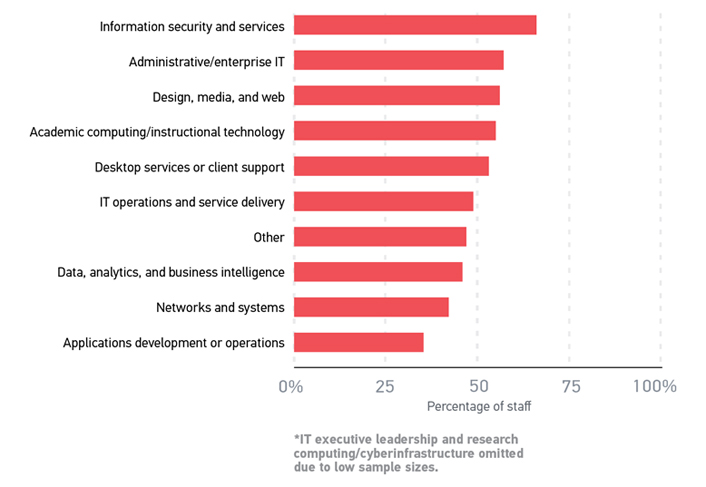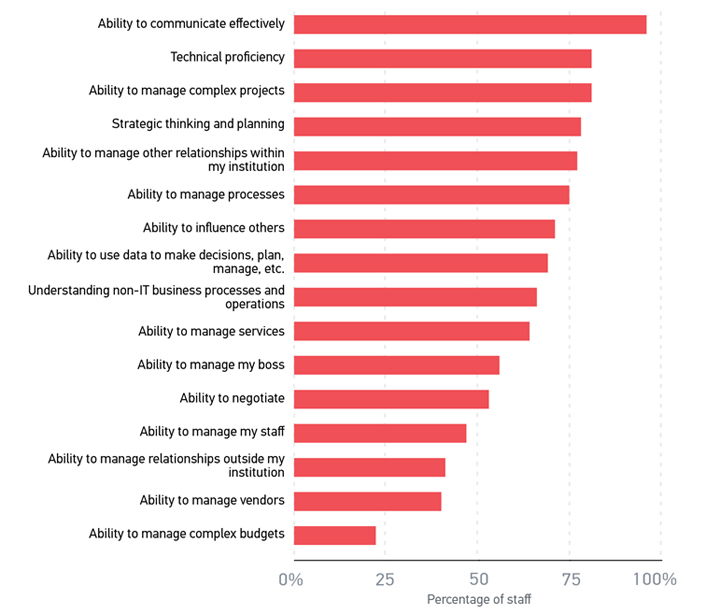Lessons from the research report The Higher Education IT Workforce Landscape, 2016 provide helpful guidance on how colleges and universities can retain IT workers and avoid unnecessary employee turnover.

Employee turnover is inevitable. According to the U.S. Bureau of Labor Statistics, nearly one in four employees in the U.S. workforce voluntarily quit their jobs in 2015.1 That percentage has been rising since 2009 and shows no sign of slowing.2
Employee turnover is expensive. According to one estimate, the median cost of employee turnover is 21 percent of the employee's annual salary3; another estimate puts this even higher, at 50–60 percent.4 Furthermore, the higher the level of specialized training a job requires, the higher the turnover costs.
Many information technology–related positions require substantial specialized training. Losing employees imposes a significant cost on IT operations, which is especially problematic in higher education, where budgets continue to shrink or remain flat.
The hiring and retention of an IT workforce appeared on the EDUCAUSE list of Top 10 issues in IT the first time that list was compiled in 2000, and it has consistently appeared in the top five issues for the past five years (figure 1). Higher education IT leaders have long recognized this issue as critical to their institution’s well-being.

Figure 1. EDUCAUSE Top 10 IT Issues, 2012–2016
The need to hire and retain an IT workforce is also urgent. The Higher Education IT Workforce Landscape, 2016 report found that fully half of all staff in the IT workforce said that they might pursue employment opportunities outside their current institution over the following year.5 Even if only a fraction of those employees indeed pursue such opportunities, and even if only a fraction of those are offered jobs, that is still potentially a lot of employee turnover. How can institutions of higher education retain employees in the IT workforce?
Who Is Job Hunting?
The Higher Education IT Workforce survey asked all respondents the question "Will you pursue employment opportunities outside your current institution in 2016?" Respondents included staff, managers, and CIOs; however, this article focuses solely on staff.
There are several ways to slice the data from the IT workforce survey, to investigate just who is more or less likely to leave their current position. The first of these slices is by sex, and here this percentage does not vary significantly: 49 percent for men and 46 percent for women.
A second way to slice the demographics data is by age. In the Higher Education IT Workforce Landscape report, age was categorized using the Pew Research Center's definitions of generations: In 2015, Millennials were 18–34, Gen Xers were 35–50, and Baby Boomers were 51–69. Members of the Boomer generation are least likely to pursue employment opportunities outside their current institution (41 percent), while members of Generation X and Millennials are similar (53 percent and 56 percent, respectively). It is perhaps unsurprising that Boomers are unlikely to be job hunting, as the older members of this generation are approaching retirement age and for that reason might have less interest in leaving their current position. More surprising is that Millennials, who are at the start of their career trajectory, are not job hunting more than they are. David Burstein suggests that one of the defining characteristics of the Millennial Generation is their "pragmatic idealism."6 Millennial respondents' commitment to their employers, combined with our finding that 40 percent of Millennial staff say that it is very important to them that they work in higher education rather than in another sector,7 may be evidence of this pragmatic idealism, as Millennials work to affect change in higher ed from the inside. A third and final way to slice the data is by the highest degree earned. For the most part, the higher the degree earned, the more likely the employee is considering job hunting: 48 percent of employees with an associate's degree responded that they might pursue employment opportunities outside their current institution over the following year, 45 percent of employees with a bachelor's degree, 51 percent of those with a master's, and 67 percent of those with a PhD or other terminal degree. This makes sense, as in general the higher one's educational attainment, the higher a salary one commands and the more opportunities are available, especially in higher education.8 Figure 2 shows likelihood of job hunting by demographic.

Figure 2. Percentage of staff who might pursue outside employment opportunities, by demographic
The 2015 ECAR workforce survey found moderate variation in who is job hunting among IT staff occupying different types of positions in the workforce. ECAR asked respondents what their current position is and provided a list of 107 specific positions, divided into 12 categories. Staff in Information security and services positions indicated that they were the most likely to pursue employment opportunities outside their current institution, to the tune of 66 percent. This was followed by Administrative/enterprise IT positions; Design, media, and web positions; and Academic computing/instructional technology positions, at 57, 56, and 55 percent, respectively. A large percentage of potential defectors in Design, media, and web positions is perhaps not surprising, as the Higher Education IT Workforce Landscape, 2016 report found that these were among the lowest-paid positions in higher education IT. Information security and services, Administrative/enterprise IT, and Academic computing, however, are mission-critical functions, making it a challenge for the institution when staff in these positions leave. Furthermore, both of these positions require quite specialized training, making it particularly expensive to replace these staff. While staff in these three categories of positions are the most likely to be pursuing employment opportunities, it is worth noting that 35 percent or more of staff in all categories responded that they might pursue other opportunities. See figure 3.

Figure 3. Percentage of staff who might pursue outside employment opportunities, by job category
Recognizing Employees’ Value
What can IT leadership in higher ed do to reduce the percentage of staff who are job hunting? What can institutional leadership do to retain employees in the IT workforce? The answer is surprisingly simple.
Workforce survey respondents were asked to rate the importance of a variety of factors in persuading them to stay at their current institution.9 The most important factor for keeping staff is Quality of life: 91 percent of staff overall rated this "Very important" or "Extremely important." Quality of life was followed by Work environment (88 percent) and Occupational stability (87 percent), both arguably also related to an employee's quality of life. Not until the fourth-ranked item do we see a concern for tangible compensation: Benefits, which 82 percent of staff rated Very or Extremely important. Monetary compensation is even farther down the list, at 69 percent. See table 1.
Table 1. Importance of various factors in retaining staff at their current institution

There are several ways to slice these data, to investigate which factors are important for keeping staff in various demographic categories at an institution. Breaking down these data by sex, we find that the top three factors are consistent across men and women (red = 1, orange = 2, yellow = 3). By generation, the top three factors are consistent across Boomers, Generation X, and Millennials. By highest degree earned, the top three factors are consistent across education level.
In the 2014 workforce report,10 Benefits was the most important factor for keeping staff at an institution, with Quality of life a somewhat distant second. In the 2016 workforce report, Quality of life is the most important factor for keeping staff at an institution, while Benefits dropped to fourth. This shift is noteworthy in light of the continuing economic recovery in the United States. During periods of economic turmoil, people tend to focus on material security, while quality of life issues matter more in periods of growth and stability.11 While the Affordable Care Act was signed into law in 2010, the most dramatic decreases in the uninsured rate among U.S. adults have occurred since 201312 — precisely the period since the data collection for the 2014 workforce report. As the economy recovers and the national unemployment rate drops, individuals may feel freer to prioritize higher-order concerns bearing on their quality of life.
Workforce survey respondents were also asked to indicate their level of agreement with a set of statements about their current IT position, which were framed as positives: I am compensated fairly, I am highly motivated to perform my duties, etc.13 We analyzed the associations14 between these statements and whether the respondent would pursue employment opportunities outside their current institution in 2016. Almost all of these statements were negatively associated with pursuing outside employment opportunities. In other words, the stronger the respondent's agreement with these statements, the less likely the individual was job hunting.
The statement most strongly associated with being unlikely to pursue outside opportunities was "Overall, I am satisfied with my current position." More informative are some of the other statements strongly associated with staying at one's institution: "I am recognized for the value I add to the organization in ways aside from financial compensation," "I am compensated fairly," "I have the opportunity to do what I do best every day," and "This past year, I have had opportunities at work to learn and grow."
If your employer recognizes your value, effectively utilizes your skills, and provides learning opportunities, then you're not likely to be job hunting —consistent with other studies of employee happiness, which find that being appreciated for the work one does15 and having opportunities to use one's skills16 are critical to workplace satisfaction. Given our data, we can't determine the extent to which these factors directly or indirectly contribute to an employee's satisfaction with their current position, but intuitively it seems likely that they do.
Regardless of whether staff say they're likely to pursue employment opportunities outside their current institution, the statement about their current IT position with which the greatest number of staff agree or strongly agree is, Someone at work cares about me as a person. (This is the number 1 statement that Boomers and GenXers agree with, and number 2 for Millennials. (The number 1 statement for Millennials is, This past year, I have had opportunities at work to learn and grow.) That someone at work cares about you as a person is not just about having friends in the workplace, however; it means that someone takes an active interest in ensuring that you are satisfied in your work. And what fosters workplace satisfaction? Quality of life, recognition of one's value, opportunities to use your skills, and opportunities for professional development. And who is that someone taking an active interest? Probably your manager.
The Importance of Professional Development
Three questions about professional development were asked on the workforce survey, with identical lists of response options:
- Professional development activities that you have participated in
- Professional development activities that your direct manager encourages you to participate in
- Professional development activities that contribute to your professional growth
We analyzed the association between the items in these lists and whether a staff member will pursue employment opportunities outside their current institution.17 Seven items on the list of things that managers encourage staff to do were negatively correlated with pursuing outside employment opportunities, as follows in order of the strength of the correlation:
- Attend conferences focused on higher education IT
- Complete "stretch" assignments outside my role or outside my annual goals
- Take formal technical training classes
- Engage in informal peer networking
- Attend general IT conferences without a particular focus on higher education
- Create or contribute to blogs or online discussion groups
- Obtain advice from a mentor
In other words, staff members whose managers encourage them to pursue these professional development activities are significantly less likely to go job hunting. It might not be the specific professional development activities that are important here; rather, a manager's encouragement might be most important. As mentioned, critical factors in workplace satisfaction are for your manager to recognize your value and provide learning opportunities. Having your manager encourage you to engage in professional development activities punches both those tickets.
Unsurprisingly, a manager's encouragement for "none of the above" was highly positively correlated18 with staff pursuing outside employment opportunities. The specifics of a manager's encouragement might not matter much, but a lack of encouragement certainly does.
Although a manager's encouragement for a wide variety of professional development activities was negatively associated with a staff member's job hunting, actually participating in these same activities is not associated with job hunting, either negatively or positively. This seems strange: talk outweighs action? Consider, however, that staff may engage in professional development both to help with their current job and to better prepare for their next job. Engaging in professional development activities does not correlate with job hunting precisely because these activities are so broadly useful.
And staff engage in a lot of professional development activities: Nearly everyone (90 percent) reads about current IT news, for example, while 68 percent have engaged in informal peer networking and 55 percent have attended a higher education IT conference. The professional development activities on the workforce survey (and perhaps all professional development activities) can be grouped into three categories: learning, networking, and building professional reputation. The top professional development activities that staff engage in cover all three.
What skills are staff trying to gain by engaging in all of this professional development? Respondents to the workforce survey were asked to rate the importance of a set of skills for success in their current IT position. Ability to communicate effectively is ranked number 1, being perceived as important for success by 96 percent of staff. This was followed by Technical proficiency and Ability to manage complex projects (both 81 percent), Strategic thinking and planning (78 percent), and Ability to manage other relationships within my institution (77 percent). Figure 4 shows how staff rated the importance of the different categories.19

Figure 4. Percentage of staff rating various skills as important for success in their current IT position
Keys to Retaining Staff
With a third to two-thirds of staff expected to job hunt, IT managers in higher ed worry about retention. What can IT departments do to retain staff?
First, remember that the job itself is largely secondary for most employees. Most people work to live, and work-life balance is crucial for workplace satisfaction. For a manager to identify what quality of life and work-life balance look like for individual employees, and then to do what's possible to help the employee realize that vision — understanding that there are always constraints — can go a long way in fostering employee satisfaction.
Employee satisfaction also comes from factors within the workplace. Being recognized for one's value to the organization and having opportunities to use one's skills and to learn new skills, are critical. Again, there are always constraints — of budget, of time, of resources. But managers are in a position to create a positive work environment for their employees, and recognition costs nothing.
For employees to engage in professional development activities does have a cost. It might not be a financial cost, but there is always a time cost. However, a manager's encouragement to engage in professional development is critical to retaining staff. The risk exists that staff who engage in professional development will leverage new skills and knowledge into a new job, perhaps elsewhere. But, especially in IT, having staff who are not learning and developing new skills would be even worse. It is not enough for a manager to simply encourage staff to engage in professional development, without at least some follow-through to enable staff members to actually engage in those activities. That depends a great deal on an institution's budget and the allocation of staff resources, which exceeds the scope of this article. But a manager's encouragement of professional development is a crucial first step, and one that communicates both the thanks of the institution and the staff member's value.
With regard to staff retention the big takeaway from the 2016 ECAR workforce study is really quite simple. The most important things that keep staff satisfied and encourage them to stay at an institution are less about their job and more about themselves. Managers must remember that people have lives outside of work, and those lives are naturally more important to them than their work. Recognize that fact and help staff achieve a work-life balance that works for them. It is also important to recognize staff for the work they do and provide opportunities to learn and grow. A manager who can do this will go a long way to promoting workplace satisfaction and employee retention.
Acknowledgments
This article is derived from a presentation titled "Should I Stay or Should I Go: Lessons Learned from the Clash and ECAR's Higher Ed Workforce Study," given at the EDUCAUSE Connect conferences in Denver, Colorado in March 2016 and Miami, Florida in April 2016. Many thanks are therefore due to the author's co-presenters in Denver and Miami, respectively, Eden Dahlstrom and Ben Shulman. Thanks also to D. Christopher Brooks, for his salary analyses of the workforce data, and to Kate Roesch, for creating the graphics for this article.
Notes
- To be precise, 23.6 percent. U.S. Bureau of Labor Statistics, Table 18: Annual quits rates by industry and region, not seasonally adjusted (March 17, 2016).
- U.S. Bureau of Labor Statistics, "Databases, Tables & Calculators by Subject" (n.d.).
- Heather Boushey and Sarah Jane Glynn, "There Are Significant Business Costs to Replacing Employees. Center for American Progress, November 16, 2012.
- David G. Allen, "Retaining Talent: A Guide to Analyzing and Managing Employee Turnover," SHRM Foundation (2008).
- Jeffrey Pomerantz and D. Christopher Brooks, The Higher Education IT Workforce Landscape, 2016, Research report (Louisville, CO: ECAR, April 2016). Exactly 50 percent of staff responded to this survey question "Definitely will," "Probably will," or "Possibly."
- David D. Burstein, Fast Future: How the Millennial Generation Is Shaping Our World (Boston, MA: Beacon Press, 2014).
- Survey responses "Agree" or "Strongly agree."
- U.S. Bureau of Labor Statistics, "Employment Projections," March 15, 2016. Salary increases with educational attainment until the Ph.D., for which there is the well-known "doctoral penalty."
- Responses to this question were a Likert scale, ranging from Not at all important to Extremely important.
- Jacqueline Bichsel, Today's Higher Education IT Workforce, Research Report (Louisville, CO: EDUCAUSE Center for Analysis and Research, January 2014).
- On the subject of materialism and postmaterialism see Ronald Ingelhart, The Silent Revolution: Changing Values and Political Styles Among Western Publics (Princeton: Princeton University Press, 1977), Culture Shift in Advanced Industrial Society (Princeton: Princeton University Press, 1990), and Modernization and Postmodernization: Cultural, Economic, and Political Change in 43 Societies (Princeton: Princeton University Press, 1997).
- Stephanie Marken, "U.S. Uninsured Rate at 11.0 percent, Lowest in Eight-Year Trend," April 7, 2016.
- Responses to this question were a Likert scale, ranging from Strongly disagree to Strongly agree.
- Using Mantel-Haenszel chi-square test, significant at the 0.01 level.
- Rainer Strack, Carsten von der Linden, Mike Booker, and Andrea Strohmayr, "Decoding Global Talent: 200,000 Survey Responses on Global Mobility and Employment Preferences," The Boston Consulting Group, October 6, 2014.
- Society for Human Resource Management, "Employee Job Satisfaction and Engagement: The Road to Economic Recovery," [https://www.shrm.org/hr-today/trends-and-forecasting/research-and-surveys/documents/14-0028%20jobsatengage_report_full_fnl.pdf] 2014.
- Using Mantel-Haenszel chi-square test, significant at the 0.05 level
- Using Mantel-Haenszel chi-square test, significant at the 0.01 level
- Responses to this question were a Likert scale, ranging from Not at all important to Extremely important. Ratings are the percent of staff who responded "Very important" or "Extremely important."
Jeffrey Pomerantz, PhD, is senior research analyst for Data, Research, and Analytics, EDUCAUSE.
© 2016 Jeffrey Pomerantz. This EDUCAUSE Review article is licensed under Creative Commons BY-NC-SA 4.0 International.
